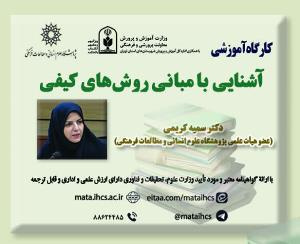موقعیت شیخ صدوق و کتاب اعتقادات او در دوره صفوی
آرشیو
چکیده
ابوجعفر محمد بن علی بن الحسین بن بابویه قمی (م 381) عالم بزرگ شیعه در قرن چهارم هجری است. یکی از آثار مهم باقی مانده از صدوق، کتاب الاعتقادات است که وی در این کتاب که چهل وپنج فصل دارد مهمترین عقاید شیعه را بیان کرده و آنها را با شواهد قرآنی و احادیث نبوی اثبات کرده است. پژوهش حاضر مطالعه موقعیت شیخ صدوق و کتاب اعتقادات او در دوره صفوی را بررسی می کند. سؤال اصلی پژوهش آن است که معیارهای اهمیت کتاب اعتقادات شیخ صدوق در دوره صفویه، در مقایسه با دیگر رسائل اعتقادی شیعی، در چه دامنه ای از ظرفیت های تبلیغی ترویجی در این دوره بوده و تا چه اندازه تأثیر گذار بوده است؟ این پژوهش با روش توصیفی–تحلیلی بر اساس منابع و مآخذ این دوره در پی پاسخ پرسش فوق است. یافته های پژوهش نشان می دهد در دوره صفویه از ظرفیت های موجود جامعه نظیر سیاست های فرهنگی-مذهبی شاه طهماسب، نهادهای دینی و آموزشی و متون و معارف در جهت تثبیت، نهادینه سازی و گسترش مذهب تشیع در جامعه ایران بهره گرفته شده است که سبب ترجمه شماری از آثار اصیل عربی شیعی به فارسی گردید.The Position of Sheikh Sadūq and His Book "Aqā'id" in the Safavid Period
Abu Ja'far Muhammad ibn Ali ibn al-Ḥusayn ibn Bābiwayh Qumī (d. 381) was a prominent Shia scholar in the fourth century of the Islamic calendar. One of the important works left by Sadūq is the book "Aqā'id," in which he elaborates on the most important beliefs of Shia Islam in its forty-five chapters, proving them with Quranic verses and Prophetic traditions. The present research examines the position of Sheikh Sadūq and his book "Aqā'id" in the Safavid period. The main question of the research is to what extent the importance criteria of Sheikh Sadūq’s book "Aqā'id" in the Safavid era, compared to other Shia doctrinal treatises, have utilized the capacities for promotional activities in this period and how influential it has been. This research, utilizing a descriptive-analytical method based on sources and references of this period, aims to answer the above question. The findings of the research indicate that in the Safavid period, the existing capacities of society, such as the cultural-religious policies of Shah Tahmasb, religious and educational institutions, and texts and teachings, were utilized to stabilize, institutionalize, and expand Shia Islam in Iranian society, leading to the translation of several original Arabic Shia works into Persian.







